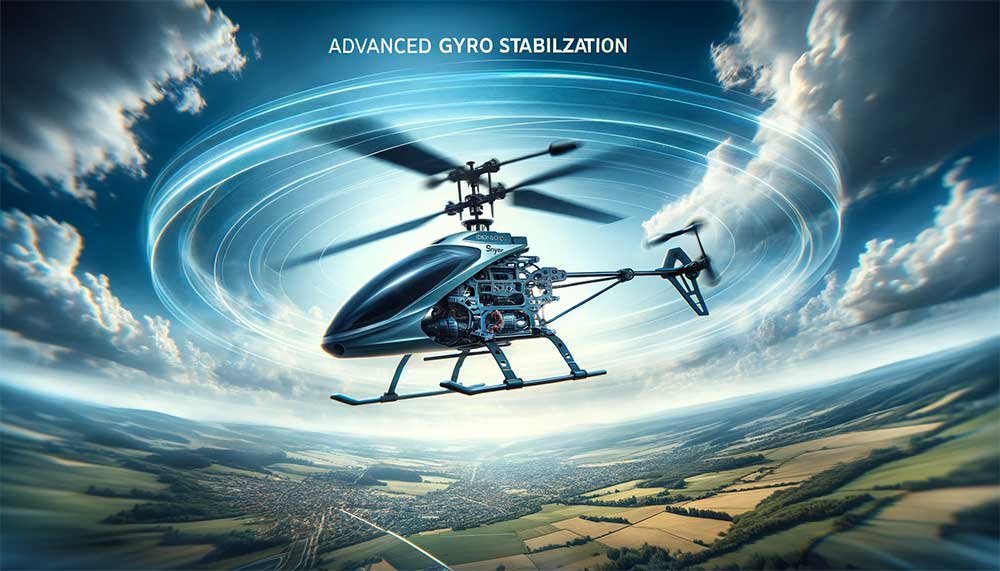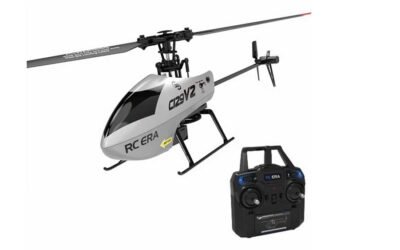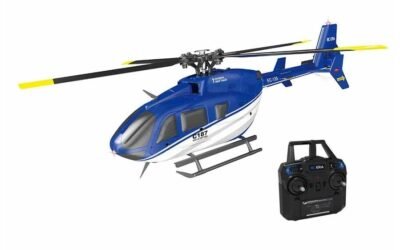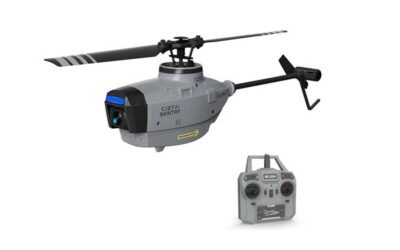Gyro RC Helicopters: A Technical Overview
Gyro RC helicopters use advanced gyroscopic systems for stable flight, making them easier to control. They feature rate and heading hold gyros for precise orientation, and 3-axis gyros for enhanced maneuverability.
“In the world of flight, stability is not just a feature; it’s a necessity.”

Introduction
Remote-controlled (RC) helicopters have captivated the hearts of hobbyists and technology enthusiasts alike. Among these, gyro RC helicopters stand out for their advanced technology and stability.
In this article, we will delve into the technical aspects of gyro RC helicopters, exploring their unique features, gyroscopic systems, and how these innovations revolutionize the experience of flying model helicopters.
The Basic Mechanics of Gyro RC Helicopters
At the heart of a gyro RC helicopter lies its gyroscopic system, a pivotal component that distinguishes it from traditional RC helicopters. This system, often a MEMS (Micro-Electro-Mechanical Systems) gyro or a piezoelectric gyro, is responsible for stabilizing the helicopter during flight.
It works by detecting any unwanted rotational movement and automatically adjusts the tail rotor’s speed to counteract these movements, thus ensuring a stable flight.
Types of Gyros in RC Helicopters
- Rate Gyros: These are the most basic form of gyro stabilization. They maintain the helicopter’s orientation but do not hold a specific position. When the pilot stops input, the rate gyro returns the helicopter to a neutral state.
- Heading Hold Gyros: More advanced than rate gyros, heading hold gyros keep the helicopter on a fixed heading. This is particularly useful for aerobatics and stable hovering, as the helicopter maintains its direction even when external forces, like wind, try to alter its course.

The Role of Gyros in Flight Stability
The gyro’s role in flight stability is paramount. It constantly monitors the helicopter’s orientation, sending rapid corrections to the servos that control the rotor blades.
This automatic adjustment is what makes gyro RC helicopters much easier to fly compared to their non-gyro counterparts. The gyro compensates for factors like wind turbulence and pilot errors, making the flight smoother and more enjoyable.
Comparison with Traditional RC Helicopters
Traditional RC helicopters, without gyro stabilization, demand high skill levels from pilots. They are prone to instability, making hovering and complex maneuvers challenging.
In contrast, gyro RC helicopters offer a more forgiving flight experience, ideal for beginners and experienced pilots who seek precision and control in their flights.
Technological Advancements in Gyro RC Helicopters
Recent advancements in gyro technology have led to the development of 3-axis gyros.
Unlike single-axis gyros that only stabilize yaw movements, 3-axis gyros offer complete control over yaw, pitch, and roll. This results in an unprecedented level of stability and control, opening new possibilities in RC helicopter aerobatics and flight dynamics.
The Importance of Electronic Speed Controllers (ESC)
An often-overlooked component in the gyro RC helicopter ecosystem is the Electronic Speed Controller (ESC). It plays a crucial role in managing the motor’s speed and responsiveness.
A high-quality ESC ensures smooth acceleration and deceleration, contributing to the overall stability and maneuverability of the helicopter.
Remote Control Systems and Their Impact
The remote control system is the pilot’s interface with the helicopter. Modern transmitters offer multiple channels and programmable features, allowing pilots to fine-tune the helicopter’s response to their liking.
Features like dual rates and exponential controls let pilots adjust the sensitivity of the controls, making the helicopter more or less responsive based on their skill level and flying style.
Battery Technology and Flight Time
Advances in battery technology have significantly improved the flight time of gyro RC helicopters.
Lithium Polymer (LiPo) batteries offer high energy density, leading to longer flight times and reduced weight.
Proper battery management and understanding the balance between battery capacity and helicopter performance are key to maximizing flight duration and enjoyment.

The Future of Gyro RC Helicopters
The future of gyro RC helicopters is bright, with continuous improvements in gyro technology, battery life, and materials used in construction.
The integration of GPS and advanced flight control systems are beginning to blur the lines between hobbyist RC helicopters and professional UAVs (Unmanned Aerial Vehicles).
Key Takeaway Points
|
Key Point |
Description |
|
Gyroscopic System |
Provides stability by adjusting the tail rotor’s speed. |
|
Types of Gyros |
Includes rate and heading hold gyros for different levels of control. |
|
Flight Stability |
Enhanced by gyroscopic systems, making for easier control. |
|
Technological Advancements |
Introduction of 3-axis gyros for superior stability. |
|
Remote Control Systems |
Modern transmitters with multiple channels for customized control. |
|
Battery Technology |
Advancements like LiPo batteries improve flight time. |
Conclusion
Gyro RC helicopters represent a remarkable blend of technology, engineering, and the sheer joy of flying. They provide an accessible entry point for beginners and a high ceiling for skill development for experienced enthusiasts.
As technology continues to evolve, so too will the capabilities and enjoyment of flying these incredible machines.
FAQs
- What makes a gyro RC helicopter different from a traditional RC helicopter?
- A gyro RC helicopter uses a gyroscopic system to stabilize its flight, making it easier to control and more stable in the air compared to traditional RC helicopters.
- Can beginners easily fly a gyro RC helicopter?
- Yes, the gyro stabilization makes it much more beginner-friendly, offering a stable flying experience.
- What are the main types of gyros used in RC helicopters?
- The main types are rate gyros and heading hold gyros, with heading hold gyros providing a higher level of stability.
- How long can a gyro RC helicopter fly on a single battery charge?
- Flight times vary based on the battery and helicopter model but typically range from 5 to 15 minutes.
- Are gyro RC helicopters suitable for aerobatics?
- Absolutely, especially models with 3-axis gyros, which offer greater control and stability for performing complex maneuvers.
You May Also Like
Related Posts
Can I Learn to Fly a RC Helicopter as a Hobby?
Master the basics of RC helicopter flying with our beginner’s guide. Tips on choosing your first helicopter, learning to fly, and joining the community.
Can I use my phone to control an RC helicopter?
Learn how to use your smartphone to control an RC helicopter with our easy guide. Explore Bluetooth and IR technologies for a seamless flying experience.
How do you fly a RC helicopter for beginners?
Master the art of flying RC helicopters with our beginner’s guide. Learn essential flying tips, control mastery, and maintenance advice to soar high!
More Models
RC ERA C129 V2 Review: What Makes It Stand Out
Explore the RC ERA C129 V2’s advanced features, its suitability for beginners, and how it’s revolutionizing remote-controlled flight.
Why Choose RC ERA C187 for Your Hobby
Explore the exciting world of the RC ERA C187 Helicopter. This guide offers tips, reviews, and techniques for beginners and pros alike.
RC ERA C127AI Review: Tech Specs and User Feedback
Explore the revolutionary RC ERA C127AI with advanced tech, user-friendly features, and expert reviews. Learn why it’s the top choice for RC enthusiasts.







0 Comments